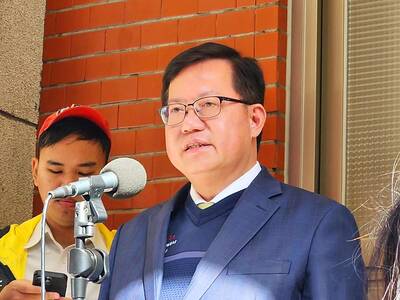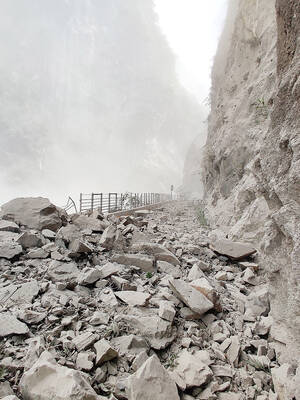Ancient DNA helps explain why northern Europeans have a higher risk of multiple sclerosis than other ancestries: It’s a genetic legacy of horseback-riding cattle herders who swept into the region about 5,000 years ago.
The findings come from a huge project to compare modern DNA with that culled from ancient humans’ teeth and bones — allowing scientists to trace both prehistoric migration and disease-linked genes that tagged along.
When a Bronze Age people called the Yamnaya moved from the steppes of what are now Ukraine and Russia into northwestern Europe, they carried gene variants that today are known to increase people’s risk of multiple sclerosis, researchers reported Wednesday.

Photo: AP
Yet the Yamnaya flourished, widely spreading those variants. Those genes probably also protected the nomadic herders from infections carried by their cattle and sheep, concluded the research published in the journal Nature.
“What we found surprised everyone,” said study co-author William Barrie, a genetics researcher at the University of Cambridge. “These variants were giving these people an advantage of some kind.”
It’s one of several findings from a first-of-its-kind gene bank with thousands of samples from early humans in Europe and western Asia, a project headed by Eske Willerslev of Cambridge and the University of Copenhagen who helped pioneer the study of ancient DNA. Similar research has traced even earlier cousins of humans such as Neanderthals.
Using the new gene bank to explore MS was a logical first step. That’s because while MS can strike any population, it is most common among white descendants of northern Europeans and scientists have been unable to explain why.
The potentially disabling disease occurs when immune system cells mistakenly attack the protective coating on nerve fibers, gradually eroding them. It causes varying symptoms — numbness and tingling in one person, impaired walking and vision loss in another — that often wax and wane.
It’s not clear what causes MS although a leading theory is that certain infections could trigger it in people who are genetically susceptible. More than 230 genetic variants have been found that can increase someone’s risk.
The researchers first examined DNA from about 1,600 ancient Eurasians, mapping some major shifts in northern Europe’s population. First, farmers from the Middle East began supplanting hunter-gatherers and then, nearly 5,000 years ago, the Yamnaya began moving in — traveling with horses and wagons as they herded cattle and sheep.
The research team compared the ancient DNA to about 400,000 present-day people stored in a UK gene bank, to see the MS-linked genetic variations persist in the north, the direction the Yamnaya moved, rather than in southern Europe.
In what is now Denmark, the Yamnaya rapidly replaced ancient farmers, making them the closest ancestors of modern Danes, Willerslev said. MS rates are particularly high in Scandinavian countries.
Why would gene variants presumed to have strengthened ancient immunity later play a role in an autoimmune disease? Differences in how modern humans are exposed to animal germs may play a role, knocking the immune system out of balance, said study co-author Dr. Astrid Iversen of Oxford University.
The findings finally offer an explanation for the north-south MS divide in Europe but more work is needed to confirm the link, cautioned genetic expert Samira Asgari of New York’s Mount Sinai School of Medicine, who wasn’t involved with the research, in an accompanying commentary.

Last week, Viola Zhou published a marvelous deep dive into the culture clash between Taiwanese boss mentality and American labor practices at the Taiwan Semiconductor (TSMC) plant in Arizona in Rest of World. “The American engineers complained of rigid, counterproductive hierarchies at the company,” while the Taiwanese said American workers aren’t dedicated. The article is a delight, but what it is depicting is the clash between a work culture that offers employee autonomy and at least nods at work-life balance, and one that runs on hierarchical discipline enforced by chickenshit. And it runs on chickenshit because chickenshit is a cultural

By far the most jarring of the new appointments for the incoming administration is that of Tseng Wen-tsan (鄭文燦) to head the Straits Exchange Foundation (SEF). That is a huge demotion for one of the most powerful figures in the Democratic Progressive Party (DPP). Tseng has one of the most impressive resumes in the party. He was very active during the Wild Lily Movement and his generation is now the one taking power. He has served in many of the requisite government, party and elected positions to build out a solid political profile. Elected as mayor of Taoyuan as part of the

April 29 to May 5 One month before the Taipei-Keelung New Road (北基新路) was set to open, the news that US general Douglas MacArthur had died, reached Taiwan. The military leader saw Taiwan as an “unsinkable aircraft carrier” that was of huge strategic value to the US. He’d been a proponent of keeping it out of Chinese Communist Party (CCP) hands. Coupled with the fact that the US had funded more than 50 percent of the road’s construction costs, the authorities at the last minute renamed it the MacArthur Thruway (麥帥公路) for his “great contributions to the free world and deep

Moritz Mieg, 22, lay face down in the rubble, the ground shaking violently beneath him. Boulders crashed down around him, some stones hitting his back. “I just hoped that it would be one big hit and over, because I did not want to be hit nearly to death and then have to slowly die,” the student from Germany tells Taipei Times. MORNING WALK Early on April 3, Mieg set out on a scenic hike through Taroko Gorge in Hualien County (花蓮). It was a fine day for it. Little did he know that the complex intersection of tectonic plates Taiwan sits